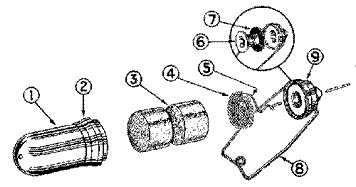Jetex 50
Original standard 50


50C – component parts

1. Motor case
2. Exhaust deflector
ring
3. Solid fuel
pellets
4. Gauze disc
5. Igniter wick
6. Flame shield
7. Cap sealing
washer
8. Wire clip
9. End cap
|
 |
Being the most popular unit of the range, the Jetex 50 underwent a series of modifications in order to keep pace with new developments.
The original standard 50, much sought after by collectors, had a turned ribbed main case and end caps.
In the U.S.A. the most popular unit was the Export 50, from which was evolved the 50B. Both differed from the standard 50 in that they had a pressed alloy case, rather than a turned one, and dome shaped ends, which were more successful with augmented thrust experiments, but necessitated a flat asbestos bottom shield.
In the 50B, being the longest motor, there was more free space for combustion and to aid wick ejection.
In order to cope with the increased heat and pressure of their own fuel, Sebel manufactured new versions. The 50C was of the same shape as the 50B, employing steel throughout, but, whilst being more durable, it still required as much attention, if not more, than the 50B in order to avoid corrosion.
An interesting feature of the 50C was the addition of a collar-like deflector in order to protect the model against blow-back, a common fault on the small lightly sprung motors. However, the collar tended to foul on the spring. The Sebel and Co leaflet shows what appears to be a sheath for mounting purposes rather than the conventional clip and this would give better protection.
In order to cater for the model rocket enthusiast, Sebel manufactured some tailored rocket models
for which the 50R version was produced in 1963, and marketed by American Telasco as the 50HT
(High Thrust). This would appear to be a modified 50C motor as the motors
both have the same external diameters. It was capable of tremendous thrust for a brief period,
had the highest power/weight ratio of all the motors and was easily mounted in the model by a stud at the front. Internal diameters appear to be the same
so the various types of 50 motor will accept any fuel but the 50R fuel will require a 1/8" diameter
hole through the centre.
|